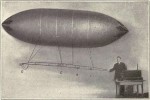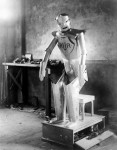 The imposing 1950s robot Cygan has been restored to his former dapper rakishness and is going on display next year at the Science Museum in London as part of its Robots exhibition which brings more than 100 historic and contemporary robots to the museum. Cygan is one 12 working robots who will be on display, his nearly eight-foot height, powerful pincer hands and renewed shiny good looks will be put to use smashing things and lifting other things for the delight of visitors, just like in the old days. No word on whether he’ll be picking up showgirls in each arm.
The imposing 1950s robot Cygan has been restored to his former dapper rakishness and is going on display next year at the Science Museum in London as part of its Robots exhibition which brings more than 100 historic and contemporary robots to the museum. Cygan is one 12 working robots who will be on display, his nearly eight-foot height, powerful pincer hands and renewed shiny good looks will be put to use smashing things and lifting other things for the delight of visitors, just like in the old days. No word on whether he’ll be picking up showgirls in each arm.
[youtube=http://youtu.be/8qy6T1BA-Oc&w=430]
 When last we saw Cygan, he was about to be sold at auction and there was an attempt to secure him for the city of Leeds as robot in residence. The attempt was not successful and on September 5th, 2013, Cygan sold to American collector Jerry Wallace for £17,500 ($27,300). Mr. Wallace intended to restore the gentle giant, and when I checked in with him a year later, he told me via email that Cygan’s condition was dire. They had to strip him down to his skeleton to remove all the rust, corroded metal, bad screws and everything else that had gone wrong in his many long years of being exposed to the elements. Wallace’s team sandblasted the skeleton and repainted it with rust-proof paint. The motors all needed to be replaced. Then they created a wireless remote system to automate his various movements. The exterior was cleaned and repaired, but the restorers left it original.
When last we saw Cygan, he was about to be sold at auction and there was an attempt to secure him for the city of Leeds as robot in residence. The attempt was not successful and on September 5th, 2013, Cygan sold to American collector Jerry Wallace for £17,500 ($27,300). Mr. Wallace intended to restore the gentle giant, and when I checked in with him a year later, he told me via email that Cygan’s condition was dire. They had to strip him down to his skeleton to remove all the rust, corroded metal, bad screws and everything else that had gone wrong in his many long years of being exposed to the elements. Wallace’s team sandblasted the skeleton and repainted it with rust-proof paint. The motors all needed to be replaced. Then they created a wireless remote system to automate his various movements. The exterior was cleaned and repaired, but the restorers left it original.
 If you’d like to hang with Cygan, you don’t have to wait until next year. He’s already out and about in the Science Museum. Meanwhile, roboticist Giles Walker will be bringing another grand old mechanical man back to life: Eric, built by Captain W. H. Richards & A.H. Reffell in 1928 and billed as the UK’s first robot. Eric was a showman too, with an aluminium plated body, light bulbs for eyes and an electrical charge that would shoot blue sparks from his teeth.
If you’d like to hang with Cygan, you don’t have to wait until next year. He’s already out and about in the Science Museum. Meanwhile, roboticist Giles Walker will be bringing another grand old mechanical man back to life: Eric, built by Captain W. H. Richards & A.H. Reffell in 1928 and billed as the UK’s first robot. Eric was a showman too, with an aluminium plated body, light bulbs for eyes and an electrical charge that would shoot blue sparks from his teeth.
[youtube=https://youtu.be/lLmohGA19Ek&w=430]
He made his debut on September 20th, 1928, at the Society of Model Engineers’ annual exhibition where he was a big hit. He traveled all over the UK, to the continent and the United States where he was roundly beloved, before disappearing without a trace. Thanks to a highly successful Kickstarter campaign, Eric will be rebuilt. We have the technology.  What we don’t have is a lot of information about how he was made. His creators kept their secrets close to their chests, so all we have to go on is a few stories in the press of the period and a few relevant papers curators were able to secure from descendants of Richards and Reffell. Between those archives, period photographs and films and a little deductive reasoning, Walker will make if not an exact replica, a pretty damn close approximation of the original Eric for the Robots Exhibition.
What we don’t have is a lot of information about how he was made. His creators kept their secrets close to their chests, so all we have to go on is a few stories in the press of the period and a few relevant papers curators were able to secure from descendants of Richards and Reffell. Between those archives, period photographs and films and a little deductive reasoning, Walker will make if not an exact replica, a pretty damn close approximation of the original Eric for the Robots Exhibition.
Does Eric really deserve the title of the UK’s first robot, though? New Zealand inventor Captain Alban Joseph Roberts had a robot skating the streets of London eight years before Eric was a twinkle in Captain Richards’ eye. Robot aficionado and researcher par excellence Reuben Hoggett of Cyberneticzoo has has the scoop about him (and about Eric, for that matter). Roberts created an automaton named Kaiser who he controlled by remote control light waves. Unlike Eric who was fixed to the power box under his feet, Kaiser could walk, or glide, and he didn’t need to carry a giant battery box to do it.
Here’s a 1920 Pathe’ newsreel of Kaiser rolling around and opening his arms with his stylish headdress and cape.
[youtube=https://youtu.be/3GDyktZKpuE&w=430]
Roberts had an eclectic approach to invention. An expert in electricity who ran the municipal electrical utility in Patea, New Zealand, when he was 24 years old, he would go on to experiment with remote control flight, both vessels (dirigibles, cars, ships) and devices (marine and aerial torpedoes). In 1912, he held a demonstration of a remote-controlled model dirigible 10 feet long which he made fly around the Lyceum Theater in Sydney and drop a toy bomb on the precise spot indicated by an audience member, a proto-drone, basically. Scientific American called him “the Edison of Australia,” an intended compliment foiled by the fact that Roberts was from New Zealand.
 He also worked on vehicles flying and terrestrial controlled by sound and light. In 1916, he created a resonator that could operate a model aircraft with sound (Sci Am article about it page one, page two). In 1920, the same year he took Kaiser for its first spin, he operated a driverless car with a whistle. The newspaper account of the demonstration presciently explained the significance of Roberts’ invention: “it may mean that before long we shall be able to explode a mine or fire a battery in Constantinople by pressing a button in London.” Again in 1920, as if he wasn’t busy enough that year, he also took a turn to the whimsical when he demonstrated a synesthesia machine that translated the tones of the human voice into different colors.
He also worked on vehicles flying and terrestrial controlled by sound and light. In 1916, he created a resonator that could operate a model aircraft with sound (Sci Am article about it page one, page two). In 1920, the same year he took Kaiser for its first spin, he operated a driverless car with a whistle. The newspaper account of the demonstration presciently explained the significance of Roberts’ invention: “it may mean that before long we shall be able to explode a mine or fire a battery in Constantinople by pressing a button in London.” Again in 1920, as if he wasn’t busy enough that year, he also took a turn to the whimsical when he demonstrated a synesthesia machine that translated the tones of the human voice into different colors.
In a move that Cygan would later copy with gusto, Roberts spent the 1920s on the vaudeville circuit, first with light and sound control demos, then operating a second robot of his invention that trundled around on a wheeled base and could move its mouth as if speaking. It didn’t have Kaiser’s legs, though. The electronics in its base were covered by an Arabian costume. You can see Roberts demonstrate it on the streets of London on January 1st, 1928, in this newsreel. (They attribute the demonstration to the magician Jasper Maskelyne, but it’s Roberts, who was a part of his show, operating the remote.)
Captain Roberts moved from inventing potential wonders of the world to show business to plain ol’ business. He died in 1950 with much of his early genius forgotten.
 So was Eric the UK’s first robot? I’m not sure what criteria the Science Museum is using, but even if you disqualify the Arabian fellow because it doesn’t have the tin man form with functioning legs and arms, Kaiser still has Eric beat by close to a decade. The only leg they have to stand on is that Eric was called a “robot” (the R.U.R. on his chest stands for Rossumovi Univerzální Roboti, or Rossum’s Universal Robots, after a 1920 play by Czech writer Karel Čapek which introduced the word “robot” to the English language), while Kaiser was called an automaton, but that’s a shaky leg. The Robots exhibition includes automata going back to the 16th century, after all.
So was Eric the UK’s first robot? I’m not sure what criteria the Science Museum is using, but even if you disqualify the Arabian fellow because it doesn’t have the tin man form with functioning legs and arms, Kaiser still has Eric beat by close to a decade. The only leg they have to stand on is that Eric was called a “robot” (the R.U.R. on his chest stands for Rossumovi Univerzální Roboti, or Rossum’s Universal Robots, after a 1920 play by Czech writer Karel Čapek which introduced the word “robot” to the English language), while Kaiser was called an automaton, but that’s a shaky leg. The Robots exhibition includes automata going back to the 16th century, after all.